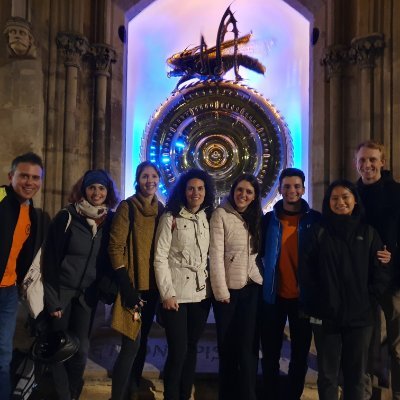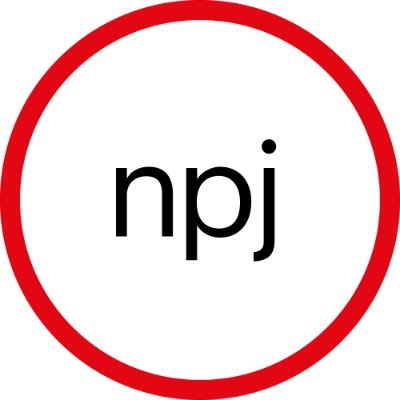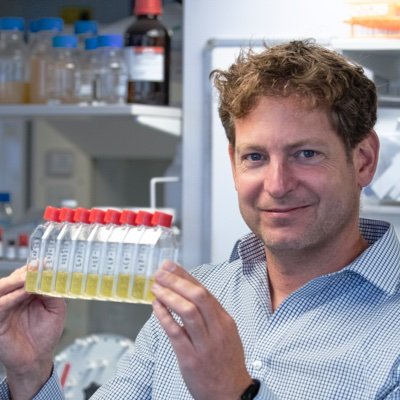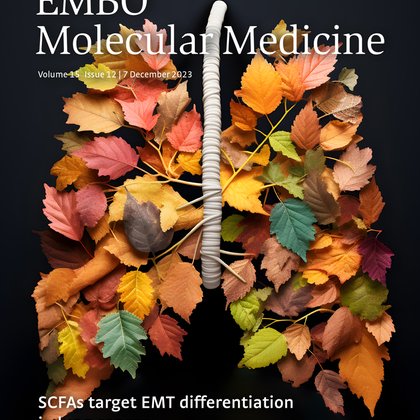
O'Neill Lab
@ONeill_Lab
Followers
712
Following
111
Media
22
Statuses
151
We study cellular circadian rhythms at @mrc_lmb @CellBiol_MRCLMB. Account accessed by all members of the lab (inc John very very rarely)
Cambridge, UK
Joined October 2019
Our first papers have been published in npj Biological Timing and Sleep! 🎉 We're proud to share two studies that highlight the journal's mission to showcase high quality research on all aspects of sleep, circadian and other biological rhythms: https://t.co/6tJdQHcJe6
#npjbts
1
7
9
Out today! Circadian rhythms in proteome turnover, especially macromolecular complexes, which allow proteome renewal even under cellular proteostasis, osmostasis, and energy homeostasis constraints: https://t.co/LxldfhzvR0
embopress.org
imageimageProtein homeostasis is costly to maintain but indispensable for normal cellular function and must be maintained in the face of daily rhythms in global protein production. Here, various...
3
11
45
Our latest work is out as a preprint on #bioRxiv ! Work by @Serffest , @PriyaCrosby and many others looking at #potassium rhythms in coupling between the #circadian clock and cell cycle. Collaboration with @partchlab @ONeill_Lab and @Alestang01
https://t.co/8UarwtYD4N
1
6
21
Come join our team? We have a postdoc position open. Deadline 17th March https://t.co/c9kevTTFd2
0
10
9
A tweet back to circadian biology: John and Andrew @DrBatmo were interviewed on the EMBO podcast about the story behind our recent paper on physiological function of red blood cell rhythms. Link below
In the new #EMBOPodcast, John O'Neill and Andrew Beale of @MRC_LMB talk to us about how a mysterious band on a Western blot led to a fascinating paper on circadian rhythms in red blood cells.
0
3
9
And save the date for an exciting #proteostasis conference @BabrahamInst 8-9 May next year! More details will be announced soon but it’s looking like a great line-up! 4/4
0
5
8
We've dabbled in another non-circadian project with @RachelSEdgar - showing that propylene glycol (PG) has robust virucidal activity in vitro and in vivo and efficiently abolishes influenza A and SARS-CoV-2 infectivity within airborne droplets: https://t.co/DYTcRXz1yZ
embopress.org
image image Existing and emerging viruses pose a great threat to the human population. We show the non‐toxic small molecule propylene glycol (PG) rapidly inactivates airborne and surface virus...
0
1
22
@Nature @MargotRiggi @janetiwasa @RachelSEdgar @DeriveryLab @_JosephWatson @estere_s @AndreiMih23 @Lara_K_Kruger @KerrieMcNally1 @Corelli_1653 @MichalDudekPhD @Silvia_Bar01 @AiweiZeng21 @Neurocool @DrBatmo @jorgmorf @chrismil941 @guna_alina @brugueslab @voorheeslab @je_chambers @UKRI_News @HFSP @wellcometrust @royalsociety @EMBO @ImperialInfect @PoLDresden If anyone wants to know why this is relevant to understanding circadian timekeeping and the daily regulation of mammalian physiology, check out Stangherlin et al, 2021 ( https://t.co/4RSnvaTrkA) and watch this space. There is more to come soon! 16/16
nature.com
Nature Communications - Osmotic compensation by electroneutral ion transport buffers TORC1-mediated changes in the cytosolic proteome, and maintains intracellular homeostasis and cell volume over...
0
2
20
@Nature @MargotRiggi @janetiwasa @RachelSEdgar @DeriveryLab @_JosephWatson @estere_s @AndreiMih23 @Lara_K_Kruger @KerrieMcNally1 @Corelli_1653 @MichalDudekPhD @Silvia_Bar01 @AiweiZeng21 @Neurocool @DrBatmo @jorgmorf @chrismil941 @guna_alina @brugueslab @voorheeslab @je_chambers Thanks also to editors and anonymous reviewers who thoughtfully helped improve this work! and also to our funders @UKRI_News, @HFSP, @wellcometrust, @royalsociety, @EMBO, @ImperialInfect, Versus Arthritis, Grifols, the Alpha-1-Foundation, Volkswagen ‘Life’ and @PoLDresden. 15/16
2
0
6
@Nature @MargotRiggi @janetiwasa @RachelSEdgar @DeriveryLab @_JosephWatson, @estere_s, @AndreiMih23, @Lara_k_kruger, @kerrieMcNally1, @Corelli_1653, @MichalDudekPhD, @Silvia_Bar01, @AiweiZeng21, @Neurocool, @DrBatmo, @jorgmorf, @chrismil941, @guna_alina, @brugueslab, @voorheeslab, @je_chambers 14/16
1
0
6
@Nature @MargotRiggi @janetiwasa Thank to all of our amazing collaborators who made this work possible. The project was led by three labs, @RachelSEdgar lab, @DeriveryLab and ourselves, and also involved so many scientists across many different institutes! 13/16
1
1
6
@Nature We summarize the key results in the animation below, put together by the amazing @MargotRiggi from the Animation lab @janetiwasa (and split over two tweets because of Twitter limitations!). 11/16
1
2
13
@Nature In a nutshell, we propose that beyond any specific roles within complexes/condensates, metastable proteins have a collegial function to act as a first line of defense that protects cells against thermo-osmotic perturbation long enough for them to deploy their defenses. 10/16
1
1
6
@Nature This built-in fast biophysical feedback mechanism does not require metabolic energy. Over longer timescales, if the challenge is maintained, cells adapt to move the “set point” around which they can buffer through changes in protein surface chemistry (e.g. phosphorylation). 9/16
1
1
5
@Nature Our data suggest buffering occurs through rapid changes in macromolecular assembly, particularly condensation/decondensation of disordered proteins. Because condensation leads to a reduction in total surface area:volume ratio, water molecules are liberated upon condensation. 8/16
2
1
7
@Nature Because temp. and osmolarity affect water availability faster than known compensatory mechanisms (secs versus min/h), we hypothesized the existence of a fast-acting mechanism that buffers the availability of cytosolic free water to accommodate with physiological fluctuations 7/16
1
0
5
@Nature For example, cells can be rescued from an otherwise lethal cold shock by the application of a hypo-osmotic culture medium. 6/16
1
1
8
@Nature Specifically, temperature and extracellular osmolarity both affect water availability. We show that the effect of changes in one stressor can be offset by opposing changes in the other because of their convergent effects on water availability. 5/16
1
0
7







